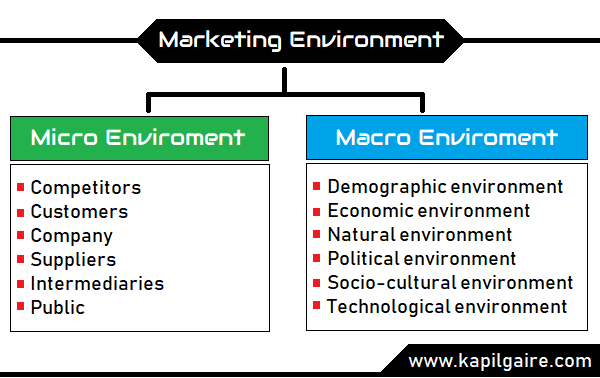Marketing environment refers to the situation, surroundings, atmosphere, and circumstances within which sustain activities are conducted. The factors that affect marketing management's ability to build and maintain successful relationships with target customers is marketing environment. It includes micro and macro environmental factors. The factors which are in the control of the company are micro environmental factors and those factors which are beyond the control of the company are macro environmental factors. Firms need to understand their marketing environment so that they can grab the opportunities and cope (deal with) the threats efficiently.
According to Philip Kotler, "A company's marketing environment consists of the factors and forces outside marketing that affect marketing management ability to develop and maintain successful relationship with its targeted customers."
Features of Marketing Environment
- Dynamic: Firms operate in a dynamic environment and they have to change with the changing marketing environment to survive in the long-run. Marketing management is nothing without the management of marketing environment. Change management is essential.
- Complex: Marketing environment is complex and very difficult to predict accurately. It provides confusion and uncertainty. Skilled, knowledgeable, and experienced manpower is essential to analyze the marketing environment.
- Beyond control: Marketing environmental factors such as demographic, economic, natural, political, socio-cultural, and technological do not have any control of the firm, they are beyond the control of the business firm.
- Internal and external: Marketing environment consists of internal (microenvironmental) and external (macro environmental) factors. A business firm has to deal with them effectively and efficiently to save their existence.
- Related with SWOT: Marketing environment is related to strength-weakness, opportunities-threats. Internal environment is related with strength and weakness whereas, external environment is related with opportunities and threats. Analyzing SWOT helps the organization to develop it's marketing plan and strategy.
Classification of Marketing Environment
Marketing environment can be classified into two categories i.e. micro environment and macro environment.
Micro Environment
The micro environment consists of those elements of the environment that impacts on the firm but they do not affect all firms. It consists of that forces which remain close to the company that affect its ability to serve its customers. They are explained as follows:
- Competitors: Competition is another element of micro environment of marketing. A company should give maximum satisfaction to the consumers by providing quality products or services compared to the competitors. Besides, the company should be able to remain in the heart of customers by maintaining more effective product positioning than the competitors. Same marketing strategy cannot be fit for all companies. So, each company should adopt suitable strategy according to or considering the size, nature, scope of activity, life cycle, etc. of the company. Big companies can, sometimes, adopt such strategy using their power. But small companies can do so. But bigness or size of any company is not everything. Small companies also can achieve greater success by developing much more appropriate strategies than big companies can.
- Customers: Customers is also an important element of micro environment. The company should study and analyze customer markets. There are five types of customer markets. They are consumer market, business market, reseller market, government market, and international market. Customer market includes individuals or members of families who buy products or services for personal consumption. Likewise, business market buys raw materials for the purpose of further processing or use in production process and government markets buy products or services in order to provide public services. Finally, international markets consists all these markets in other countries, including consumer, reseller, and government.
- Suppliers: Suppliers provide materials and other resources to a company. As the supplier greately affects marketing, it is taken as an important element of marketing environment. Supplier should be renowned, financially sound, and able to supply quality materials on a regular basis. Besides this, terms and conditions of sale also should be favorable. The supply should be cost effective.
- Intermediaries: Market Intermediaries are either individuals or business houses who come to the aid of the company in promoting, selling and distributing the good to the ultimate consumers. They are Middleman (wholesalers, retailers and agents), distributing agencies, marketing service agency and financial intermediaries. Most of the companies find it too difficult to reach the consumers. In such a case the agents and distribution firm help to reach the product to the consumer.
- Public: Public is also a component of micro or internal environment of marketing. Public is any group that has actual and potential interests in or impact on organization's ability to achieve its objectives. There are different types of public, such as financial publics, media publics, citizen action publics, local publics, general publics, internal publics, and government publics. These different kinds of public affects the business firm's marketing decisions.
Macro Environment
Macro environment is an environment external to the organization and is filled with factors and variables over which the organization has little control. This is a wider environment consisting of factors and conditions surrounding the organization. These factors and conditions include demographic, economic, natural, technological, political, and cultural forces. These factors affect the functioning of a business organization and put tremendous pressures on a marketing manager. The job of a marketing manager here is to keep in view of these factors.
Economic Environment of Marketing
Economics forces are those factors that affects consumer purchasing power and spending patterns of people. It consists of income distribution, purchasing power, percapita income, inflation rate, trade cycle, willingness to spend, and other elements.
- Income distribution: Income distribution is one of the important elements of economic environment. There is uneven distribution of income. The people with high income can purchase more and the people with low income can purchase less. Hence Income distribution affects the market.
- Purchasing power: Purchasing power of consumers directly affects marketing decisions. The purchasing power of the consumers is influenced by economic system of the country, level of income of consumers, inflation rate, income of other family members, spending pattern, and so on. Availability or unavailability of credit facility also affects purchasing power of consumers.
- Per capita income: Per capit income indicates the purchasing power of the market. The higher the per capita income, the higher will be the purchasing power and vice versa. Even within the country, there may be regional variations in per capita income.
- Inflation: Inflation is rate of change of prices calculated on a monthly or anual basis. It influences the purchasing power of money. When inflation rate goes up, there is decline in the purchasing power of money and vice versa.
- Trade or Business Cycle: A trade or business cycle indicates the health of the economy. It is the periodic but irregular up-and-down moment in the economic activity, measured by fluctions in real gross domestic product (GDP) and other macroeconomic variables. A business cycle is characterized by four phases- recession, recovery, growth, and decline. Such kinds of fluctuations movements in economic activity directly influence the buying power of the people.
- Willingness to spend: Willingness of a customer to spend depends on his/her buying power, family background and the prevailing and expected economic conditions. For example, when the people come forward to make investments and their willingness to spend increases.
Demographic Environment of Marketing
Demography is the study of human population in terms of size, density, location, age, gendwer, race, occupation, and other statictics. The demographic environment is of major intrest to marketers because it involves people and people make up markets. The main demographic forces that marketers monitor are population size, population growth, migration, urbanization, age mix, gender, and occupation.
- Population size: Total population of a country is the indicator of the potential market size. The higher number of population size indicates the greater market potential. India and China are the most attracting markets of the third world because of their population size.
- Population growth:The world population is showing explosive growth. Growth rate indicates expansion or contraction of the market potential. Population growth is highest in countries that can least afford it. Underdeveloped countries account for 76% of the world population and are growing at 2% per year, whereas the poplulation in developed countries is growing at only 0.6% per year.
- Migration:Migration of people also affects marketing decisions. People may migrate to urban from village, one country to another country, and so on. When the people migrate from one place to another, market also migrates with them. It also directly affects in marketing decisions.
- Urbanization:People provide opportunities to marketing. When the people migrate to urban area from rural areas or villages, they adopt urban lifestyle and begain to demand for products or services suitable to the urban life style, which directly affects in the marketing decisions.
- Age mix:Age mix also plays important role in marketing decisions. Purchasing behaviour and capacity of various age groups is diffrent. Age group below 14 and above 65 usually remain inactive in activities so their purchasing power is low. Whereas, age group from 14-65 remain very active in working and they have high purchasing power.
- Gender:Gender of people also affects the marketing decisions. Buying behaviour of male and female could be different. There are approximately 3.38 billion females and about 3.41 billions males in the world.
- Occupation:Occupation also affects the marketing decisions. Purchasing capacity and behaviour would be different as per occupation. For example, purchasing capacity and behaviour of doctor and accountant would be diffrent.
Political Environment of Marketing
Marketing decisions are strongly affected by developments in the political environment. The political environment consists of laws, government policies, government agencies and pressure groups that influnce or limit various organizations and individuals in a given society.
Even the most liberal advocates of free-market economies agree that the system works best with at least some regulation. Well- conceived regulation can incourgae competition and ensure fair market for goods and services. Thus governments develops public policy to guide commerce. Set of laws and regulations limit business for the good of society as a whole. Almost every marketing activity is subject to a wide range of laws and regulations. Following are the major forces of political environment:
- Laws: All economies require some kind of regulation. Political process shapes a busines's laws. Laws protect business firms from unfair cometition. It protects consumer from unfair business practices and protect the interests of society from unrestrained business behaviour. The legislative framework thus creates both opportunities and challanges for marketers. The constitution is the fundamental law of the nation. All laws inconsistent with it are void to the extent of such inconsistency.
- Government policies: Trade policy, industrial policy, privatization policy, environment policy, foreign investment policy, taxation policy, etc. affects marketing decisions. Goverment policise should be stable and favourable to business organigations. If government policies is not stable and favourable then intrest toward investment in business sectors will be decreased.
- Government agencies: Government agencies are the administrative bodies of the government which bear specific responsibilities. Such agencies provide license, fix quotas, provide loan, pledge as guarantor, and provide relief to industries.
- Pressure groups: Marketing decisions are also affected by pressure groups. Consumers' forum, and child labor group, women rights group, etc. are some pressure groups. They raise voice for the group interests and give pressure to government or related bodies.
Socio-cultural Environment of Marketing
Socio-cultural environment includes attitudes, beliefs, values, perception, language, religions, and so on. They directly and indirectly affect marketing decisions.
- Attitudes: An attitude is an expression of favour or disfavour towards a person, time, leisure, work, guests, business, or event. People's attitude is affected by education, language, culture, belief, etc. It can be pesitive or negative. Positive attitude is favourable for marketing activities.
- Beliefs: Belief is a state of the mind, treated in various academic disciplines, especially philosophy and psychology, as well as traditional culture, in which a subject roughly regards a thing to be true. Beliefs of people affects the marketing decicions.
- Values: Cultural values are ideas about what is good, right, and fair. It may affect differ form groups to groups within a culture. According to Robert K. Merton, the most important values in American society are wealth, success, power, and prestige but that everyone does not have an equal opportunity to attain these values. Values are most complex and can influence the marketing decisions.
- Perception: Perception is the ability to see, hear, or become aware of something through the senses. Human perception may be different. It is also complex to understand. It also affects marketing decisions.
- Language: Language is the medium of communication, either spoken or written, consisting of the use of words in a structured and convential way. It is deep-rooted force of cultural environment thay may affect marketing decisions.
- Religions: Religion is a particular system of faith and worship. It is also deep-rooted force of cultural environment It is very complex and strong. There are followers of diffrent religions like Hindu, Muslim, Jain, Christian, etc. and they has diffrent attitude, beliefs, values, perception, etc. Religion also influences in marketing decisions.
Natural Environment of Marketing
Natural environment involves natural resources that are needed as inputs by marketers or that are affected by marketing decisions. Natural resources, topography, climate, etc. are elements of natural environment.
- Natural resources: Natural resources are materials or substances occurring in nature which can be extracted for economic gain such as raw materials, mines, land, forest, etc. These elements play an important role in marketing decisions.
- Topography: Topography is a detailed map of the surface features of land. It includes the mountains, hills, creeks, and other bumps and lumps on a particular hunk of earth. It plays an important role in transportation and distribution of products. It directly influences the cost and time of transportation.
- Climate: Climate is the weather conditions or atmospheric conditions of particular area. Climate can be hot, mild, and cold. For example, the demand for cotton clothes is more in terai region whereas the demand for warm clothes is more in mountain region of Nepal. Thus, climate directly affects demand and marketing decisions.
Technological Environment of Marketing
Technology is an important element of macro environment of marketing. It includes level of technology, technological change, technology transfer, pace of technology, and R&D activities. They directly and indirectly affect marketing decisions.
- Level of technology: The level of technology can be labor incentive and capital incentive. Human labor is used for operation of business in labor incentive whereas automatic, digital or robotized technology is used for operation of business in capital incentive. Thus, appropriate technology should be adopted in the production process.
- Technology transfer: Technology transfer is the key for successful marketing activities. The pattern of technology transfer are foreign direct investment, joint ventures, turn-key projects, licensing and capital transfer, contract manufacturing, franchising, technical assistance. The major factors influncing by the technology transfer include improving production process, product design and packaging, pricing, advertisement, marketing, marketing information, etc.
- Technological change: Technology is dynamic. The pace (rate or speed) of change of technology is very fast. Marketers should adopt new technology. Products obsolete, new improvements, new product, and big market opportunities are the results of technological change.
- R&D activities: Research and development activities have become essential elements of modern marketing. Grater innovativeness in product and service are outcome of research and development activities conducted by the company. Multinational companies are continuous allocating huge amount of budget for research and development activities. And customers are getting new products with higher value. Hence, research and development activities plays an important role in marketing decisions.
References
- Principles of marketing. Kotler, P. & Armstrong, G. (1997).
- Wikipedia, Market environment
- Fundamental of Marketing. BBS 2nd Year, Asmita publication
- Funadamental of Marketing. BBS 2nd Year, Dr. Sherjung Khadka (2017), Samjhana Publication





